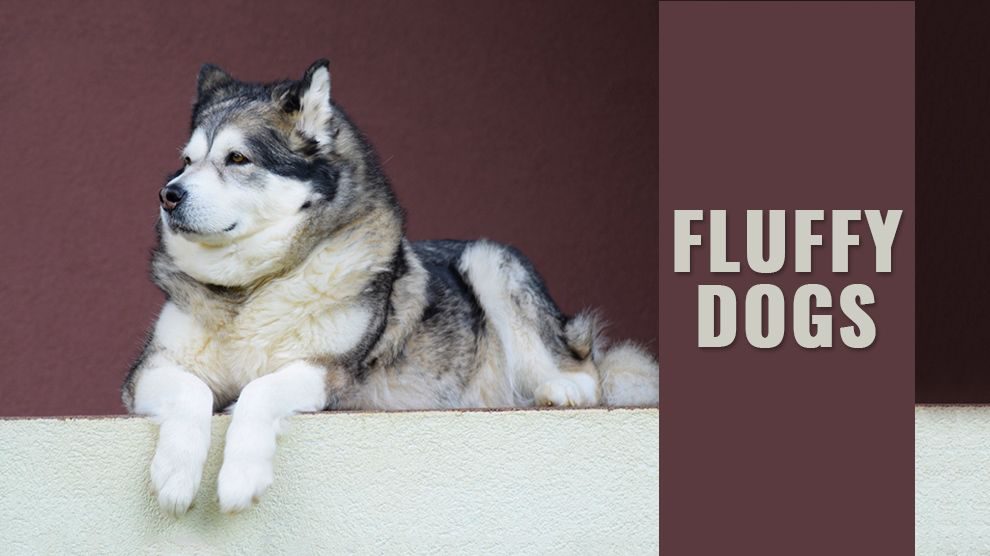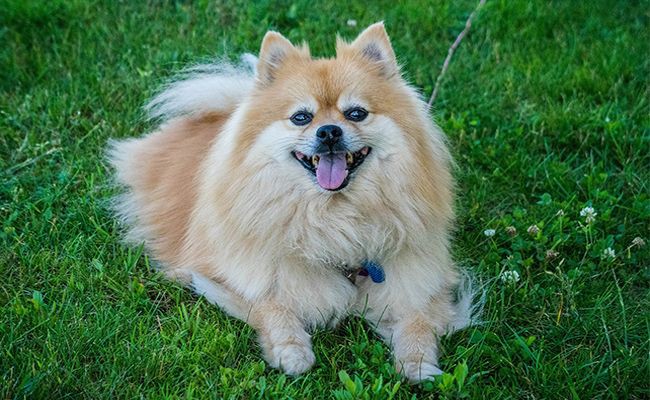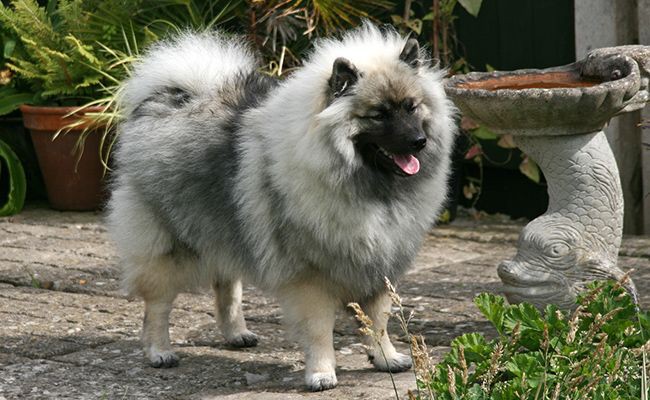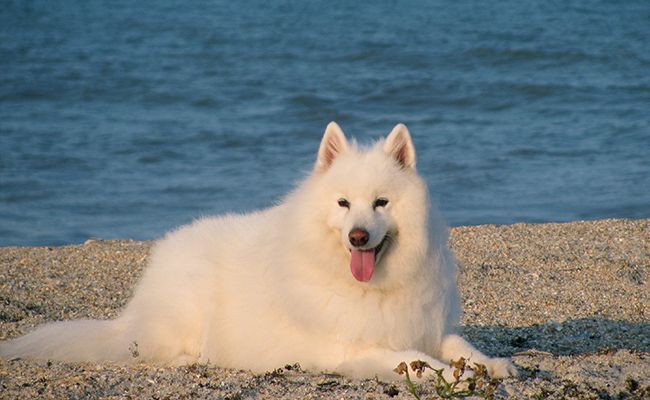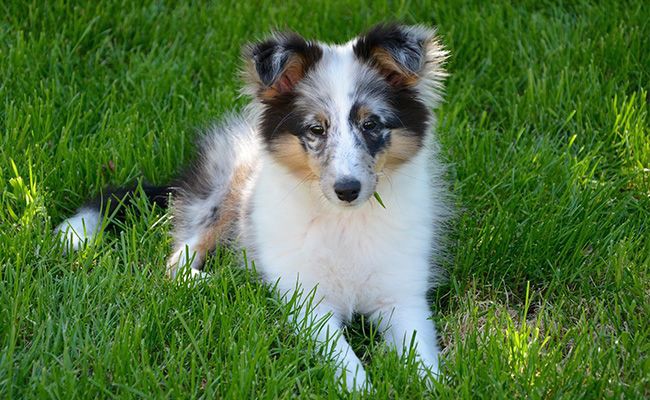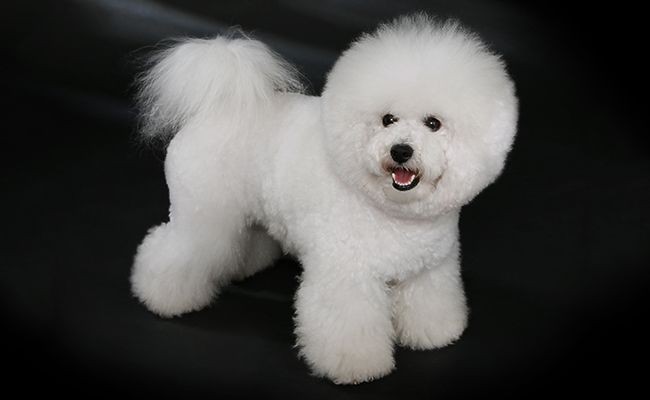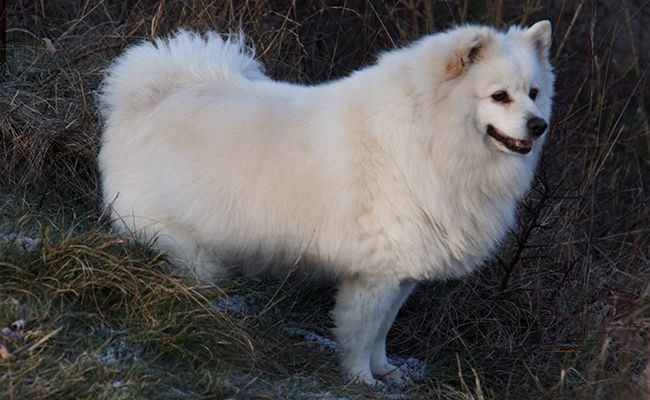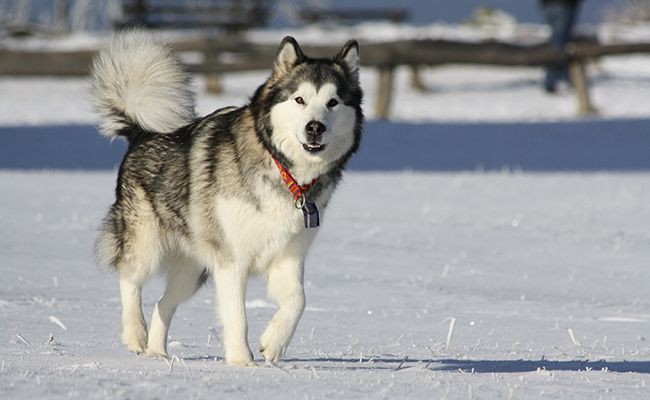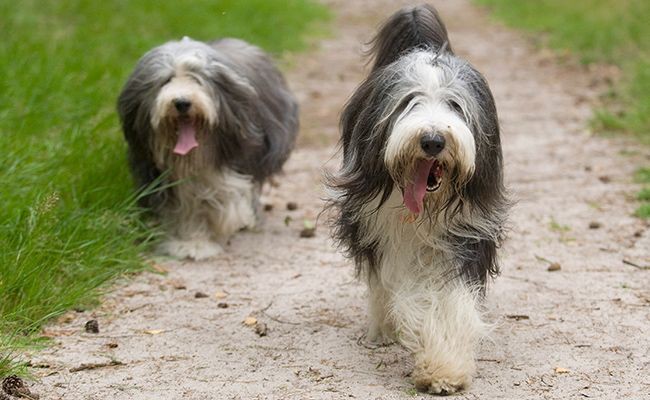Dog Pregnancy Calculator And Timeline
Fluffy dogs are magical. They are out of this world. And Yes! These dog breeds are waiting to be all yours!
If you were planning to buy some white, silky, velvety, smooth, soft cushion pillows, then wait a second. You better miss that trip to your nearest home décor shop and get yourself a new fluffy dog.
Are we kidding? Probably, sort of!
If you are in that part of the world where winters are long or just want some extra warmth, cute fluffy dogs can offer some pleasant snuggle sessions and excellent foot-warming services.
Take a look at some of the most beautiful fluffy dogs that are guaranteed to spice up your life in a jiffy.
Pomeranian
- Height – 6-7 inches
- Weight – 3-7 lbs
- Lifespan – 12-16 years
- Group – Toy group
History
Pomeranians have acquired their name from “Pomerania” town in Germany. Pomerania, in short, means “Land by the sea.” These dogs are descendants of large sled dog breeds.
These breeds became very popular when Queen Victoria had allowed her pets to participate in a conformation show.
Appearance
With an ideal weight between 3-7 lbs, Pomeranians are related to sled dogs of Lapland and Iceland.
The Nordic ancestry is visible in their plush superior, heavily plumed tail and plush double coats.
Pomeranians have foxy faces with their pointy ears, but it’s their temperament that catapults them on the world stage now and then.
Temperament
Highly extrovert dogs, these dogs exhibit a keen sense of a vivacious attitude and intelligence. They are not only outstanding therapy dogs but also perform well in sports activities, including therapy dogs.
Poms are ideal for participating in the conformation ring due to their ”I’m the boss” attitude.
This supreme nature has uniquely placed them on a popular pedestal in history.
Unknown Facts about Pomeranians
- The real name of “Minute Waltz” composed by Frederic Chopin is “Little Dog Waltz” or “Valse du Petit.” Inspired by a Pom chasing its tail, Frederic Chopin has said to have composed this piece.
- The great Austrian composer Mozart owned a Pom named Pimpernel.
- Painter Michelangelo worked on the Sistine Chapel from 1508-1512 with a Pom by his side.
- Queen Victoria, at one point in her life, had close to 35 Pomeranians. In fact, she was the first to organize a dog show for her Poms.
- When the Titanic sank, the Poms happily survived the watery grave, proving that they are spunky little dogs who can escape any adversity.
Keeshond
- Height – 18 inches(male), 17 inches(female)
- Weight – 35-45 lbs
- Lifespan – 12-15 years
- Group – Non-Sporting group
History
The Keeshond represents a nimble-footed, hardy dog who worked as a companion and guard dog on Dutch vessels.
Keeshonden was the sign of the Dutch Patriots Party. The name might resemble two leaders called “Kees.” These dogs are almost the most preferred companion dogs, even nowadays.
Appearance
These sturdy dogs descend from the spitz-type dogs that include Samoyeds and Pomeranians. The Keeshond dogs are also called Dutch Barge Dogs.
“Spitzy” Keeshonden consists of a plumed tail, an abundant coat, pointed ears, and a foxy face.
The “spectacles” or the distinct markings or shadings around the eyes promote Keeshonden’s impression of wearing trendy eyewear.
The spectacle markings draw importance to an intelligent, alert expression.
Temperament
The Keeshond is not overly aggressive or timid but, instead, is friendly and outgoing with both other dogs and people.
Keeshonden are an affectionate, active, intelligent, and smart companion. Keeshond barking prosperity depends on how long the dog is left alone.
Grooming and Shedding
The Keeshond needs regular brushing. This dog sheds its undercoat at least twice a year. The fluffy outer coat puffs away, giving the dog it’s present look.
Unknown Facts about Keeshonden
- The name Keeshond is pronounced as “Kayz-hawnd.”
- Keeshonden appeared in infinite cartoons and pictures that were part of the Dutch political party.
- The Patriots were once led by a leader named Kees de Gyselaer. His pet dog was called Kees. Kees, in turn, gave the breed its name and later became the identity of the Patriots.
- Keeshonden served on a lot of vessels plying on the river Rhine.
- The Keeshond puppies are a fan of winters or specifically cold weather.
Chow Chow
- Height – 17-20 inches
- Weight – 45-70 lbs
- Lifespan – 8-12 years
- Group – Non-sporting group
History
The Chows are considered one of the oldest dog breeds, and records show Chows are progenitors of certain spitz-type species.
Most of the time, they served as lordly friends to Chinese nobles.
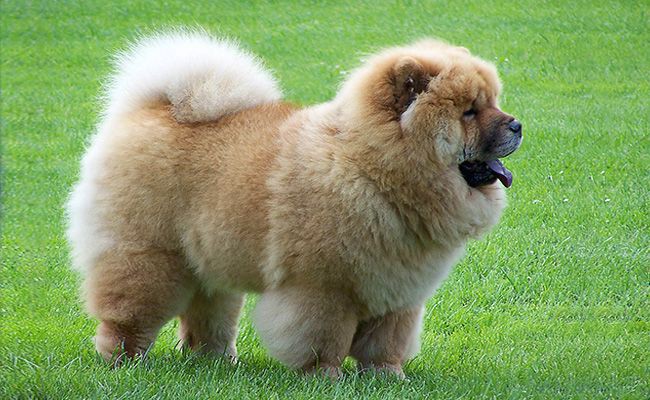
Appearance
Chows are strongly built, standing as tall as 20 inches. These dogs have a unique lion’s mane ruff near the shoulders and head, a sturdy-legged gait, snobbish expression, almond eyes, and a blue-black kind of tongue.
Temperament
Chows are one of the cleanest dogs. These dogs housebreak quite easily, carry little dog odor, and are meticulous as cats.
Early-socialized and trained Chows are highly dignified and refined but never intractable or fierce. The owner needs patience and must do things for these dogs in a consistent manner.
Chows are loyal to their near and dear. They happily enjoy the urban atmosphere with adaptable or serene nature.
Grooming and Shedding
Both the Chows require regular grooming. A monthly bath and a thorough brushing can maintain the dog’s coat and skin healthy.
Puppy coat can turn ugly with mats if not adequately groomed regularly.
Keeping the coated mat free is a big task, and you can use an air dryer to dry your dog after a bath thoroughly.
Unknown Facts about Chow Chow
- TV personality Martha Stewart owns a lot of Chows.
- Chows perform well as a sporting, guard, and companion dog.
- Archaeological reports suggest that Chows were part of hunting events as early as 150-200 BC in China.
- A Tang Dynasty emperor was believed to have had around 5000 Chow dogs.
- The name “Chow “ means “edible” in Cantonese.
- These dogs are not really fond of cuddles and fussiness, but they stay quiet if their owner does so.
Samoyed
- Height – 21-23.5 inches(male), 19-21 inches(female)
- Weight – 35-50 lbs(female), 45-65 lbs(male)
- Lifespan – 12-14 years
- Group – Working group
History
Samoyeds, the cutest sled dogs, were mainly bred to work in the coldest locales. Originally bred to hunt, haunt rein deers, and haul sleds, these are strong-willed dogs.
In Oymyakon, a Siberian town, for instance, the temperature can reach minus-60 degrees. The coat of this dog protects it against freezing conditions.
Appearance
Sammy’s white fluffy coat safeguards it against all such cold conditions. Impervious to cold, tireless, agile, and strong, Sammies are stunningly beautiful but steadily functional. Weighing between 35 – 60 pounds, they have broad heads and pricky ears.
These dogs have upturned corners, and these prevent the Sammies from drooling.
Temperament
Sammies are mischievous, social dogs who demand attention and love. When it comes to training, Sammies require a firm, kind, but complimentary hand. Sammie’s love to thrive in human companies.
As pack animals, they should be taught that the alpha dog is you and not them.
Grooming and shedding
This dog consists of a double coat. The outer coat consists of harsh hair and a wooly, thick, soft undercoat.
These dogs shed well once or twice a year.
Daily cleaning or brushing will remove loose hairs and dirt and make the dog look best.
A metal comb or slicker brush can remove all the tangles and mats.
Trim the nails once every three or four weeks.
Unknown facts about Samoyeds
- The Arctic snows and suns have literally bleached the dog’s coat and tipped it with an icy sheen.
- Named after the Samoyeds, primitives of the Sayantsi family, the Samoyeds included a nomadic tribe. This tribe extended all the way from Iran.
- Queen Alexandra loved Samoyed. The descendants of this dog appear in a lot of American and English kennels today.
- Sammies accompanied Amundsen in his South Pole conquest in 1911.
Shetland Sheepdogs
- Height – 12.9-16 inches
- Weight – 14.1-26 lbs
- Lifespan – 12-14 years
- Group – Herding group
History
Originating from Scotland’s Shetland Islands, these herding dogs were once called Shetland Coolie. The Shetland Sheepdog is a herding dog that comes from Scotland’s Shetland Islands. These dogs served local farmers as herd dogs herding poultry, ponies, and sheep.
These dogs were called “Toonie” dogs.
Thanks to their small size, the Shetland dogs eat comparatively less than the large herding dogs and Collies.
Appearance
The Sheltie is an agile, alert, and small herding dog with 13-16 inches. The long coat remains straight and harsh with a thick undercoat. These dogs have a wedge-shaped head, three-quarters size erect ears, with a deep-chested torso.
Temperament
Smart and ready-to-please, the Shetland Sheepdogs are world-class champions and comfortable trainers in herding, agility, and obedience trials.
The Shelties are highly friendly and sensitive family dogs. They love barking but behave poorly toward strangers.
Grooming and Shedding
The Sheltie owners must be ready to brush the coat at least weekly once, and more during the shedding season. Check formats in the “pants” near the tail, under the dog’s elbow on the front leg, and mats behind the ears.
Shaving the dog must be avoided; the coat safeguards against cold, heat, and sunburn.
They do need a bath but not frequently, but occasionally. Trim the nails as regularly as possible.
Unknown facts about Shetland Sheepdogs
- The Sheltie is regarded as one of the finest obedience dog breeds.
- The first Shetland Sheepdog, according to AKC, was John Sherman’s “Lord Scott.”
- These dogs were virtually out of the radar until the late 19th century or early 20th
- Shelties eat much less than other herding dogs and Collie.
Pekingese
- Height – 6-9 inches
- Weight – 14 lbs(max)
- Lifespan – 12-14 years
- Group – Toy Group
History
A Chinese legend states that the Pekingese was actually created by Lord Buddha, who mystically shrunk a big lion down to small dog size.
For many centuries, Chinese aristocrats were immersed entirely with the breeding of lapdogs and cherished these dogs’ companionship.
The Shih Tzu, Pug, and Peke are good surviving examples of their handiwork. Stealing Pekingese invoked the death penalty at that time.
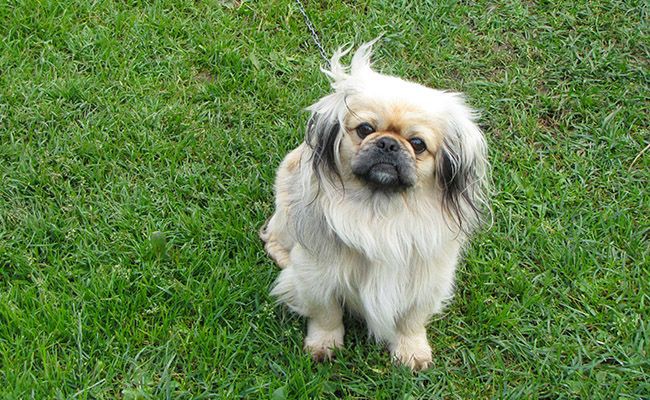
Appearance
Pekingese are stocky, compact dogs weighing not more than 14 lbs. The coat remains longest at the shoulders and neck, giving them the distinct “lion’s mane.”
Coats are seen in different shades of red, from a normal golden-red to darker red shades.
The muzzled head is more expansive than a rectangle. Pekes have sparkly, dark, and large eyes.
Temperament
Pekes are confident, charming companions who create a strong bond with their owner. Ideally made to stay in palaces, Pekes can remain as strongly independent as the kings who owned them.
Always alert, they make good watchdogs.
These dogs can tolerate kids but will not handle a lot of buffooneries.
Grooming and shedding
The double coat of the Pekes ideally needs a little bit of maintenance. Pekes shed seasonally.
Brushing the Pekes at least once a week can prevent matting, and tangles and mats can be cleared with a metal comb and a slicker brush.
Trim the nails as regularly as possible, and overly long nails lead to dog discomfort.
Unknown Facts about Pekingese
- The Pekingese entered the Western World as a result of looting at Peking in 1860 by the British.
- Considered sacred in China, and Pekingese dog idols have been presented down through generations.
- These dogs were also called Sleeve Dogs, Sun Dogs, and Lion Dogs.
- The Pekes were shown in England, not before the 19th century.
- One of the earliest known records of this breed is traceable back to the Powerful Tang dynasty.
Bichon Frise
- Height – 9.5-11.5 inches
- Weight – 12-18 lbs
- Lifespan – 14-15 years
- Group – Non-sporting group
History
Bichons belong to the Barbichon family of dogs that also includes the Maltese, Havanese, and Bolognese. It’s widely believed that these dog breeds originated on the Tenerife Islands.
One of these native breeds struck a chord with the sailor community, and it was later called Bichon Tenerife.
Appearance
A healthy-sized Bichon will definitely fall a little bit short than afoot at the shoulders. The breed’s highlight is the cute white low-shedding hypoallergenic coat, soft and cushion-like to the touch.
Bichons’ head hair sets off the dark, large eyes and black features of the lips and nose.
Temperament
Unbelievably cute, trainable, and always keen to work, Bichons were supreme candidates for showbiz performance.
Bichons are adaptable dogs who happily get along with other children and dogs. Curious and alert, these dogs make excellent watchdogs, and remember, they are not fighters and only lovers.
Their size and confidence make them good city dogs.
They are easy-to-train dogs and enjoy performing. Bichon Frise wherever they go, they draw unlimited hugs and smiles.
Grooming and shedding
Bichons should be regularly brushed two or three times every week, but daily is best.
These dogs need clipping and a bath with a good dog shampoo at least once every 30 days. Some Bichon Frise owners take their dog to the groomers once every four-six weeks.
The coat traps the shed hair, and the shed hair needs to be brushed to stop mats from forming.
Like other breeds, trim the nails of this dog regularly as well.
Unknown facts about Bichon Frise
- The Bichons descended from Water-Spaniel and later came to be known as Bichon from the name “Barbichon.”
- Spaniards regularly used Bichon as a barter item in ancient times.
- The “Bichon” gained some popularity under Francis I’s patronage, but their massive success was visible under the rule of Henry III.
- This breed also became an integral part of Spanish society, and Bichon Frise was seen in a lot of Goya’s paintings.
American Eskimo Dog
- Height – 9-12 inches (toy), 12-15 inches (miniature), 15-19 inches (Standard)
- Weight – 6-10 lbs (toy), 10-20 lbs (miniature), 25-35 lbs (standard)
- Lifespan – 13-15 years
- Group – Non-Sporting Group
History
Eskimos have no role in naming this breed, which clearly indicates that the name American Eskimo was actually a misnomer.
The Germans were responsible for bringing this breed to the United States. These stunning little dogs were considered parents of the present-day Eskie dog.
Appearance
The American Eskimo comes in three different sizes- toy, miniature, and standard.
Unique traits include a thick, dense sparkling coat including a lion-like mane around the shoulders and chest; a plumed tail, intelligent expression, eye-rims convey deep meaning.
It has a smiling face along with black lips and nose.
Temperament
Eskies are brilliant social animals. They can develop behavioral problems when undertrained or neglected.
The intelligent, kid-friendly dogs invented the term “ready to please.”
Grooming and shedding
The Eskimo Dog’s white double coat is easy to maintain. These dogs shed always. A regular brushing two to three times a week removes unwanted dead hairs.
The oil present on this dog’s fur stops dirt from gathering. An occasional bath is fine, but the skin will hurt and turn dry if washed frequently.
Just like other breeds, the Eskie’s nails need regular trimming.
Recommended Read: Dog Wash Tips
Unknown facts about American Eskimo Dog
- The American Eskimo Dog is white with biscuit cream or only white.
- An Eskie dog named Pierre walked a tight-rope in Barnum & Bailey Circus in the 1930s.
- In 1917, the name American Spitz later became American Eskimo.
Alaskan Malamute
- Height – 25 inches (male), 23 inches (female)
- Weight – 85 lbs(male), 75 lbs(female)
- Lifespan – 10-14 years
- Group – Working Group
History
The Alaskan Malamute remains as one of the oldest sled dogs of the Arctic. The breed gets its name from the Mahlemiut tribe that settled in Alaska a very long time ago.
The dog developed by Mahlemiut is a sturdy sled dog. These dogs pull heavy loads at only low speeds over varied distances.
Appearance
Everything about Alaskan Malamute indicates that these dogs as a splendid arctic sled dog.
The weatherproof coat, powerful shoulders, deep chest, and heavy bone suggests this is a heavyweight dog amongst Arctic dogs.
Temperament
Mals are terrific pack animals.
Positive, firm training should begin as early as possible.
A well-obedient Mal always stays great with kids, friendly, gentle, and well-behaved.
Grooming and shedding
The waterproof double coat adapts beautifully to cold Arctic life, but still, it needs regular upkeep.
Brush the Malamute daily with a metal comb and a pin brush. Twice a year, you can include the undercoat rake to the regimen.
A puppy Malamute can travel nothing less than eight weeks.
Unknown facts about Alaskan Malamutes
- The Alaskan Malamute loves to dig holes in the ground. They can be trained to dig in an allotted place, but they cannot be stopped if they begin to dig at various places.
- The breed has already appeared on different stamps in 14 countries.
- Malamutes are cousins to the Eskimo dogs, Siberian Husky, and Russian Samoyed dog.
- The Government of Alaska in the United States has officially declared the Alaskan Malamute as their official dog in 2010.
Bearded Collie
- Height – 21-22 inches (male), 20-21 inches (female)
- Weight – 45-55 lbs
- Lifespan – 12-14 years
- Group – Herding Group
History
Originally named as Mountain Collie and Highland Collie, Bearded Collies, has gained a reputation for being a driving and rugged herding dog.
These dogs were bred to help and drive the herd to the market.
Experts believe that Beardies are descendants from Komondorok and Polish Lowland Sheepdogs.
There are no records to definitely show that the shepherds and peasants of the past have used a breed similar to Bearded Collie.
Appearance
Standing not more than 20-22 inches and wholly covered in a double coat, Bearded Collies look a lot like the Old English Sheepdogs.
These exuberant dogs have large expressive eyes with a big broadhead.
Temperament
Bearded Collies are rambunctious comical dogs with around fifty pounds of energy, attitude, and character.
Well-socialized Beardies move well with all kids and animals. They get bored quickly, and the constant change of the training method is appreciated.
Since Beardies have the herding heritage, these dogs are always alert and they make good watchdogs.
Grooming and Shedding
These dogs require a grooming session consisting of two substantial parts. A daily brushing ritual will remove all the tangles and foreign matter. Secondly, a weekly grooming session is needed that includes anti-tangle spray, comb, brush, and a pin rake.
Trim the dog’s nails because long nails can lead to unnecessary pain and running and walking problems.
Unknown facts about Bearded Collies
- Researchers state that the real ancestor of the Bearded Collie is the Magyar Komondor belonging to Central Europe.
- Beardies were remarkably famous in Scotland, served as both show and working dogs.
- Chewing and barking habits can occur if these dogs fail to receive enough exercise.
- Bearded Collies are called “Dogs of Changing Colors” due to the fading gene.
- They are finicky eaters too.

